| |
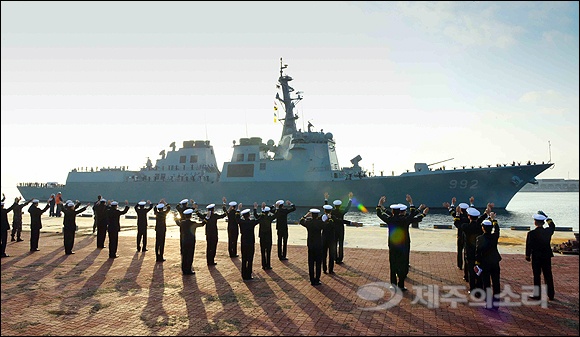 |
|
| ▲ The arrival of the 7,600-ton Aegis destroyer Yulgok Yi on Dec 22 at Jeju Civilian-Military Complex Port Photo courtesy Jeju Sori |
With the arrival of the 7,600-ton Aegis destroyer Yulgok Yi on Dec 22, the fate of Gangjeong, a once sleepy village along Jeju’s beautiful southern coast, looks to be sealed.
Jeju Civilian-Military Complex Port, as the official title runs, loomed perpetually on the maritime horizon, yet its militaristic shadow now reaches inland, beyond the construction site and dogged anti-base protesters.
The village’s die were cast as far back as 1993 when former president Kim Young Sam first mooted the idea of a Jeju naval base to further Korea’s maritime interests.
The plan did not progress further until 2007, when the Roh Moo-hyun administration officially selected the Seogwipo village as the naval base site.
Controversially, only 87 of over 1,000 villagers were present for an affirmative vote on the issue, and the incident sparked five years of resistance and division before construction eventually began in 2012.
At the same time, the international movement against the base grew, attracting solidarity from around the world including Okinawan activist groups, US Veterans for Peace, intellectual Noam Chomsky, and filmmaker Oliver Stone.
Detentions and arrests increased as the conflict intensified and the UN expressed human rights concerns to the Korean government in 2012 about “acts of harassment, intimidation and ill-treatment of peaceful protesters.”
| |
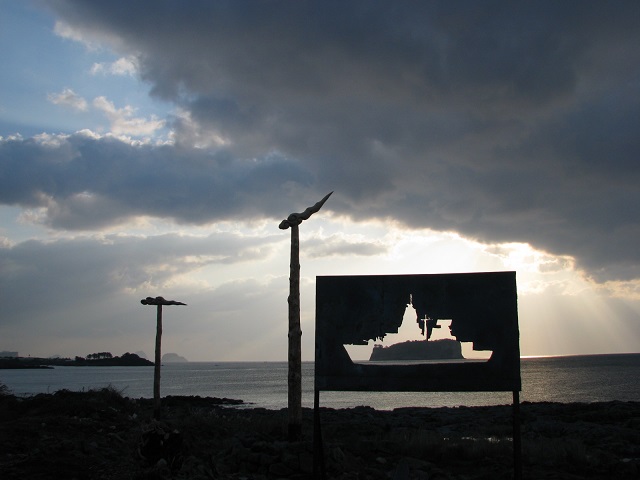 |
|
| ▲ Dark clouds gather around Gangjeong. Photo by Kang Min Soo |
Despite firing the passions of anti-base activists, the issue only simmered for much of the Jeju public, however.
Nevertheless, the waters have recently darkened over the damaged — and ecologically and spiritually significant — Gureombi rocks.
After eight years of protests and debate, the arrival of the Aegis destroyer, part of the navy's 7th Task Flotilla’s relocation from Busan, adds to the Dec 1 creation of the 9th Brigade, a marine corps brigade to be stationed at Gangjeong.
The partial relocation of the Submarine Force Command to Jeju from Jinhae had already begun in late November. The Command is tasked with not only defending against North Korea, but “potential danger to be posed by neighboring countries," reports Yonhap.
| |
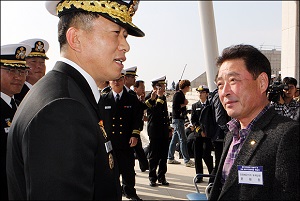 |
|
| ▲ Photo courtesy Jeju Sori |
The message is clear: the navy is in town.
After an impassioned and divisive campaign, the might of the Korean navy and government, as well as conglomerates Samsung and Daelim, seems to have secured a project that enjoys considerable establishment support.
Not only will the base eventually accommodate 20 warships, but more than 3,000 seamen and their families will settle in the local area.
With the construction reportedly 96 percent complete, and an official opening slated for early 2016, Jeju minds are now being concentrated on the local effects of the over 1 trillion won, 490,000-square-meter project.
Although the anti-base movement has inevitably lost some of its momentum, many believe it is now more important than ever to resist further militarization. Bishop Kang U-il, a prominent anti-base activist, said, “The real struggle starts from now on.”
International spokesperson for the movement, Choi Sung-Hee, echoed Kang in digging in for a long campaign.
“The task has become bigger. It is not only ourselves, but our descendants and nature... who would suffer from the militarization of Jeju,” she said.
| |
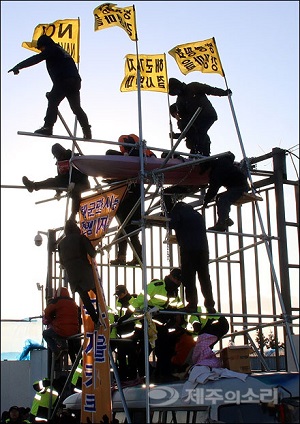 |
|
| ▲ Protesters continue their opposition to militarization on Jeju. Photo courtesy Jeju Sori |
Base opponents passionately oppose the militarization of Jeju, an island that the Korean government itself declared an “Island of World Peace” in 2005.
The issue is also soured by the 1947-54 massacre on the island (Jeju 4.3) which left an estimated 30,000 dead. Many killings occurred under US military control, and anti-base campaigners suspect US strategic objectives are driving the base project.
Rather than make Jeju more secure, opponents claim it could destabilize the region as part of Obama’s “pivot to Asia” to contain China.
The government counters that the base is Korean, and essential if Seoul is to defend itself against North Korean attack; warships will be able to reach Yeonpyeong island six hours faster than at present, they claim.
A navy captain said that the base will aid in defending against “North Korea’s possible penetration and protecting maritime transportation routes and major harbor facilities.”
China also disputes sovereignty over Ieodo islet (Socotra Rock) and the base will cut the naval response time to provocations there from nine to around four hours.
Base proponents also point to the economic boon that is expected due to the civilian port, providing simultaneous berthing for two 150,000-ton cruise ships by 2017, although construction is yet to begin.
| |
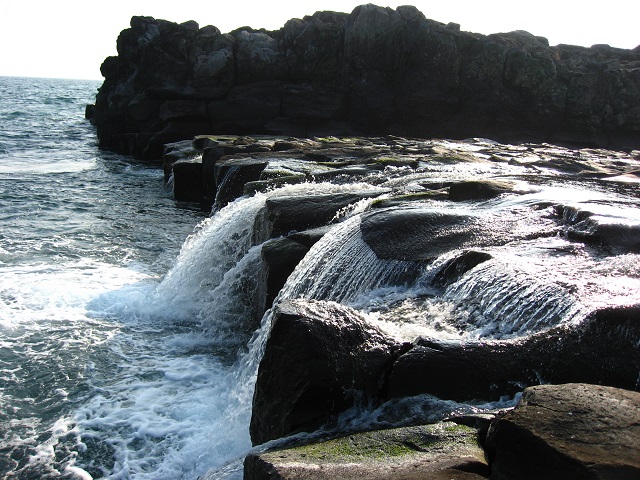 |
|
| ▲ Gangjeong river meets the Jeju sea. Photo by Kang Min Soo |
Arguments for and against aside, the base, and the accompanying increase in shipping, will have a significant environmental impact.
The damage to Gureombi rock, and the soft coral habitat that provides shelter for the endangered striped shore crab and narrow-mouthed toad, is irreversible.
In response to concerns, provincial and municipal authorities have held consultations with villagers and proposed the construction of a park within the base area around the surviving portions of Gureombi.
Of continuing concern is the location of accommodation for naval personnel and the threatened 50 billion won indemnity that Samsung and Daelim may pursue in damages from villagers due to delays in the construction.
With such a poisonous history, and the numerous unresolved issues, it is no surprise that one Korean admiral sees a great deal of work ahead in improving community relations.
“Changing someone’s mind is no easy job ― we will make constant efforts by providing support, boosting the community economy and reinforcing other mutually beneficial programs.”
As the warships and submarines roll into the coveted seas around Gangjeong, it is clear that there remain many important battles ahead. |
























